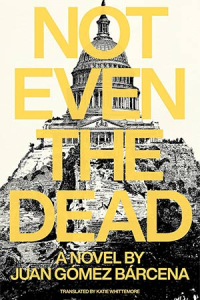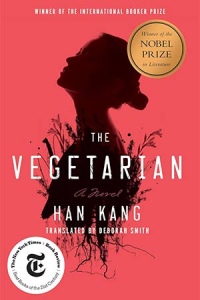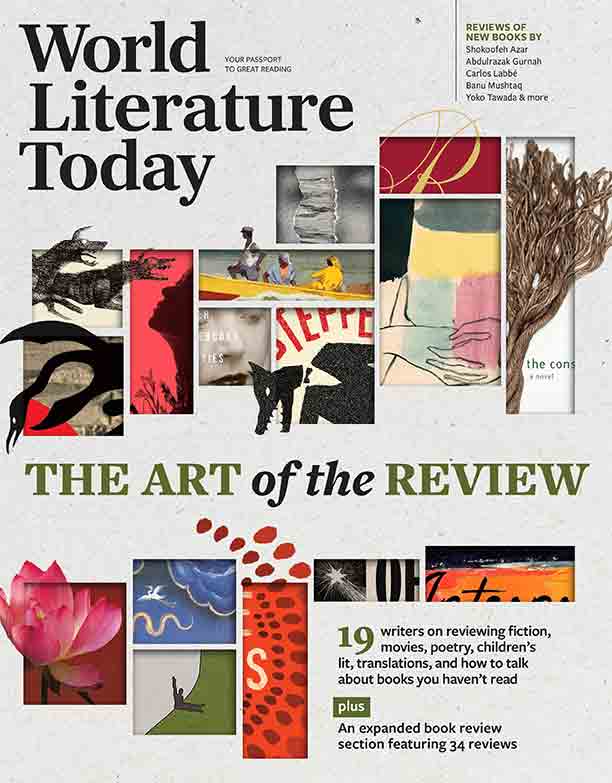Reviewing Literature in Translation: A Flowchart of Complications

A longtime publisher of books in translation—and reviewer of translations who reads some one hundred translations a year—offers some best practices for reviewing literary translations.
It’s a little bit weird, as a publisher, to be writing about reviewing literary translations. Even though the number of possible reviews a new book could receive has shrunk dramatically over the years—I remember a time when we would send review copies to several dozen local newspapers, each with their own “book review editor”—the desire to obtain as many as possible tends to be the primary focus of most marketing departments.
Sure, the impact of a positive review has also diminished over time, with even reviews in the New York Times, arguably the biggest of the big places to get book coverage, along with NPR (long live NPR!), resulting in only a fraction of the sales a NYT review generated back in the early 2000s. But these are still incredibly valuable in helping a title break through the noise generated by the hundreds of thousands (or millions if you count self-published titles) published every year. Not to mention, they fall under the rubric of “author maintenance,” the variety of marketing activities (tours, online promotions, media coverage, etc.) that help keep an author happy and bring their next titles your way.
Given the “winner-take-all” sensibility that has come to dominate the cultural sphere, with a small handful of titles receiving the bulk of book reviews and other media attention, a publisher’s dream is to get a few key reviews—all extremely positive, naturally—simultaneously, instilling pressure among both other review sources and bookstores to “get in on this,” usually in a very positive way (contrarian opinions are so 2005, not 2025), snowballing the hype and “making” a book.
When it comes to translated literature, reviews are both more valuable and more rare.
To the detriment of a robust book culture, international literature has historically been overlooked by primary review sources for a slew of reasons that will be articulated below, most of which revolve around the accepted belief among major book review editors that the general reader simply isn’t interested in translations. “America Yawns at Foreign Fiction” was the title of a 2003 New York Times article that may seem outdated—like Virginia Slims, we’ve come a long way, baby, thanks to many admirable organizations, publishers, and champions of international literature—but many of these attitudes persist, even if they’re not stated as baldly as the title of that article.
 And with literature in translation frequently selling somewhere in the range of 1,000 to 1,500 copies per title—and, far too often, fewer copies than that—major review attention can dramatically alter the bottom line. For instance, a few years back Open Letter (the publishing house I co-founded) brought out Not Even the Dead, by Juan Gómez Bárcena, translated from the Spanish by Katie Whittemore. Over four hundred pages, this is a relatively giant book that starts in the sixteenth century in the south of Mexico, then leaps through space and time, following the never-ending quest of Juan de Toñanes to capture “Juan the Indian,” who has both translated the Bible into Spanish and filled it with illustrations (blasphemy!), but also who, within the context of the book, presages major changes in the history of the world. Point being: this is a dense book, a True Literary Work that rests more on style and experimentation with form than a gripping, propulsive plot. We expected rather modest sales . . . until the New York Times gave it a glowing review and, eventually, named it as one of the fifty best works of fiction that year. It is now one of the ten best-selling titles in our history, selling five times more copies than projected.
And with literature in translation frequently selling somewhere in the range of 1,000 to 1,500 copies per title—and, far too often, fewer copies than that—major review attention can dramatically alter the bottom line. For instance, a few years back Open Letter (the publishing house I co-founded) brought out Not Even the Dead, by Juan Gómez Bárcena, translated from the Spanish by Katie Whittemore. Over four hundred pages, this is a relatively giant book that starts in the sixteenth century in the south of Mexico, then leaps through space and time, following the never-ending quest of Juan de Toñanes to capture “Juan the Indian,” who has both translated the Bible into Spanish and filled it with illustrations (blasphemy!), but also who, within the context of the book, presages major changes in the history of the world. Point being: this is a dense book, a True Literary Work that rests more on style and experimentation with form than a gripping, propulsive plot. We expected rather modest sales . . . until the New York Times gave it a glowing review and, eventually, named it as one of the fifty best works of fiction that year. It is now one of the ten best-selling titles in our history, selling five times more copies than projected.
So, before getting into the complex tangle of weeds that comes with reviewing translated literature, my publisher brain wants to scream: just do it! Whatever hang-ups a reviewer might have related to evaluating a book from another country, they should just throw them aside, dive in, and help the small presses that publish the bulk of international literature to stay afloat. (The irony of writing this in World Literature Today, the premiere magazine for coverage of international literature, is not lost on me.)
But I don’t want to write this piece from the perspective of a publisher whose reputation is almost exclusively tied to editing, publishing, and promoting literary translations. That viewpoint is way too narrow, and as someone who tries to write reviews of these books (to varying degrees of success, depending on how much you like Franco Moretti’s ideas and digressions) and reads around a hundred translations a year, I’m much more interested in the role, impact, and best practices of reviewing literary translations as a whole.
Every piece one writes brings with it its own set of anxieties. Imposter syndrome is legit, and attempting to say something useful and concise about a topic so large is pretty daunting. Especially since the sessions on book reviewing that I teach in my publishing class at the University of Rochester are generally the most discouraging.
Sure, extrapolating broad-based statements from the attitudes of undergrads and graduate students about book reviews is both extremely biased and a small sample size, but it’s hard to argue against the idea that what constitutes a book review has changed dramatically over the past couple of decades. The rise of the customer review on Amazon (which is echoed in the exclusive focus on customer ratings in Amazon’s physical bookstores), the success and influence of Goodreads, the proliferation of online book outlets from Tumblr to blogs to X accounts (which is, to be fair, where I both got my start and live most of the time), the new focus on BookTok (see all the various BookTok-related table displays in your local Barnes & Noble)—all these things and more have shifted the balance of book coverage from literary experts who take the idea of evaluating a book seriously to what is primarily reader-responses based in identifying with characters or being swept up in a plot. Book reviews writ large have become less about craft and more about ticking boxes based in personal preferences.
In this world—the subculture of book reviewing—it’s not impossible for a literary translation to get a lot of attention; however, given the baked-in level of “foreignness” to international literature, it’s unusual to come across a review of this nature that actually examines how a book is put together, how and why it works (or doesn’t), which is, in my opinion, the true value of a book review—and what we’ll be focusing on for the rest of this piece. Which isn’t meant to dismiss BookTok, etc. This level of democracy that allows all voices to be heard is definitely a net good—but let’s recenter the conversation on what makes a great book review, and what specific challenges (and maybe solutions?) a reviewer faces when taking on a work that’s in translation.
I’ll start by establishing what I believe is the goal of a good book review: to fully articulate a book’s style and what makes it a unique work of art. Even if a book “fails” when put in contrast with books deploying similar literary techniques, it will “fail” in its own particular way. If the reader of a review decides to read the book, a good review will have captured a book’s style, leaving them with a full sense of the artistic principles—structure and form, use of plot and characterization, elements of estrangement, the way sentences unfurl—and giving them a thoughtful lens through which to engage with the work.
This is in contrast to a publisher’s usual hope for a review—to receive a “selling” review that generates an urgency among readers, that they must acquire this book immediately—rather than a review that serves up a reader’s individual reaction (“the characters were appalling,” “the sentences too long”). Engaging with a work of art by meeting the book where it is and trying to understand how it’s constructed can be an incredibly rich and rewarding experience.
Engaging with a work of art and trying to understand how it’s constructed can be an incredibly rich and rewarding experience.
And yes, I get that a lot of people engage with various art forms simply for entertainment and not to dwell on the finer intricacies of what makes a book/movie/album “work.” However, the book reviews I want to talk about aren’t necessarily for these people. That’s what Rotten Tomatoes, Goodreads ratings, and, to a much lesser extent, LitHub’s BookMarks are for. A great book review doesn’t result in a quantifiable score for a book (except in Norway, where every review includes a score from one to six represented by a playing die) but rather demonstrates the book reviewer’s conscious process of coming to understand whatever it is they come to understand about a book.
For a work in translation, this immediately leads to a dilemma and two distinct pathways: you can (1) treat the book as if it had been written English, discuss its merits and shortcomings, ignoring the translator entirely in favor of the finished product before your eyes; or (2) include the art and craft of translation within your review, evaluating the successes and missteps of the translator who is, obviously, one of the two people responsible for creating the book under review.
 How to separate the accomplishments of a translation from the source material is a sort of alchemy that very few people are trained in or even feel comfortable attempting. Tim Parks has done this, most notably with Deborah Smith’s The Vegetarian, by Han Kang, which resulted in some pretty heated feedback and, for someone with less confidence in their critical skills, serves as a possible warning. This is one reason why so many translations are referred to in reviews (if they’re referred to at all) as “lucid,” “smooth,” “adequate,” “exquisite”—one or two adjectives to give a sort of blessing to the English words the translator used in rendering this text. A sort of “you did a fine job here” pat on the back, unless the book itself is subpar, in which case it’s generally (and misguidedly) implied that this is the fault of a “clunky” translation.
How to separate the accomplishments of a translation from the source material is a sort of alchemy that very few people are trained in or even feel comfortable attempting. Tim Parks has done this, most notably with Deborah Smith’s The Vegetarian, by Han Kang, which resulted in some pretty heated feedback and, for someone with less confidence in their critical skills, serves as a possible warning. This is one reason why so many translations are referred to in reviews (if they’re referred to at all) as “lucid,” “smooth,” “adequate,” “exquisite”—one or two adjectives to give a sort of blessing to the English words the translator used in rendering this text. A sort of “you did a fine job here” pat on the back, unless the book itself is subpar, in which case it’s generally (and misguidedly) implied that this is the fault of a “clunky” translation.
How to separate the accomplishments of a translation from the source material is a sort of alchemy that very few people are trained in or even feel comfortable attempting.
Translators, for reasons that should be obvious, desire more engagement with their work, since they are essential to the existence of the book in English. This frequently results in a tension between what publishers and book review editors want—coverage of particular books either for sales or to hype a new international novel—and what would be best for advancing the appreciation of the craft of literary translation.
Book review editors have traditionally explained away their “one adjective” approach by pointing out that it’s very difficult to find a reviewer capable of writing such a detailed assessment, mostly because they don’t know the source language well enough to evaluate the translation, nor do they have the time for such a comparison given the paltry amount of money reviewers get paid.
This is fine, if not ideal, for reviews written for a general public, such as what you would encounter in the New York Times, Washington Post, NPR, etc., but feels extremely weak when a review appears in a publication dedicated to promoting translations and their translators—venues such as World Literature Today, Asymptote, the Los Angeles Review of Books, or any number of more academically leaning journals. There we would expect more concrete details on the translator’s approach, what principles guided their choices, how those choices played out, and in which moments did the translator assist in making a work as excellent as it can be, or vice versa.
If a reviewer does happen to know the source language—or, in the case of a retranslation, the earlier version—they can and should include a couple of translation examples to educate and enthrall the reading public. But if you don’t have the original language, a next-best option is to use a translator’s introduction as the starting point for exploring their work. It’s a shame that more publishers don’t encourage translators to write intros or afterwords where they can articulate their processes. These can be fascinating to fans of international literature, used as marketing tools, and partially fill the gaps in knowledge a reviewer is likely to have about a new book by a previously untranslated writer.
If you don’t have the language or an introduction to lean on, a reviewer can turn to the larger context of what other books have been translated from a particular language or region. Compare and contrast a new work to what else is made available. Does this book point to a particular literary movement or break new ground? What gap in a region’s literary history does this text fill? Are there books from other regions or languages that are clear influences? Answers to these questions may not illustrate the translator’s craft exactly, but they do provide insight into the shape of translated literature as a whole and help position the author in a way that solely focusing on plot and character does not.
One easy thing that I believe all book reviewers should do is to always refer to the author and translator with an ampersand within the review itself instead of the common practice of stating “Book X, by Author Y, translated by Z” one time, then only referring to the author after that. Not Even the Dead, by Bárcena & Whittemore, is a simple thing to do and makes clear the importance of the translator. And as long as their individual roles are explained at the top of the review, there should be no confusion. It’s such a small but meaningful change in how general readers will perceive and relate to international literature by making foreign literature less “scary” and emphasizing the collaborative aspect found in all translations.
Reviewers should provide readers with a deeper understanding of how to read a particular book and do their best to engage with the work as a translation.
Which, again, is the point of all this: to provide readers with a deeper understanding of how to read a particular book and to engage with the work as a translation. This can be difficult, for sure, and leads to a series of choices based on what outlet a reviewer is writing for, what languages they know, and what paratextual elements are available. That said, engaging with texts on this level is the best way to heighten awareness of translation as an art form. Doing so will entice readers to think about international works in a more robust way based on all the elements that impact the creation and publication of a particular book. This is the sort of dialogue we need today.
Rochester, New York












